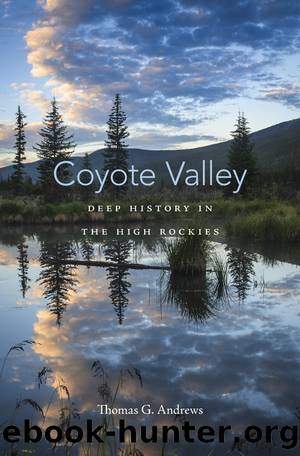Coyote Valley by Thomas G. Andrews

Author:Thomas G. Andrews [Andrews, Thomas G.]
Language: eng
Format: epub
Tags: Nonfiction, Science & Nature, Nature, Environment, Environmental Conservation & Protection, History, Americas, United States
ISBN: 9780674495357
Publisher: Harvard University Press
Published: 2015-10-05T04:00:00+00:00
The Never Summer Boundary Extension
Conservationists greeted the rise of tourism at Rocky Mountain during the 1920s with a mix of approval and anxiety. Park Service officials cited the swelling ranks of national park visitors as an index of success. Other preservationists, however, worried that the onslaught of cars, tourists, and crass commercialism would mar the scenery and spoil the experience of communing with wild nature. Defenders and critics of automobile tourism could both agree, however, that a bigger park would be a better park.
The Never Summer extension of 1930, an Act of Congress that pushed the national parkâs border westward to incorporate most of the Coyote Valley, reflected the Park Serviceâs commitment to protecting the all-important vistas from the Fall River Road and its successor, the route over Trail Ridge. As with the campaign that culminated in the 1915 law that established Rocky Mountain, however, efforts to extend the parkâs boundaries to the Never Summer ridgeline led advocates to make calculated compromises. As they licked their wounds after a failed 1925 expansion bid, park officials realized that extending Rocky Mountainâs western border would remain a political nonstarter unless they made significant concessions to local landowners. By 1930, this strategy succeeded at reversing the opposition of the Water Supply and Storage Company, owners of the Grand Ditch, to a second boundary extension proposal. Almost a century later, the aesthetic and ecological consequences of the resulting bargain continue to haunt the Kawuneeche Valley.
From the inception of Enos Millsâs park crusade in 1909, supporters had treated the preserveâs borders as expedient and subject to future modification. National Park Service administrators ranging from the top brass in Washington to the superintendents of other parks and monuments across the United States expressed similar optimism; to them, as to James Gamble Rogers, the original boundaries of these federal preserves represented but a starting point for future expansion. Because most Park Service units adjoined national forests, enlarging parks and monuments typically hinged on transferring the management of these public lands from the Forest Service to the Park Serviceâa dynamic that exacerbated the already heated rivalry between the two agencies. By the 1920s, border controversies had erupted from Yellowstone to Yosemite, and from Glacier to Grand Canyon. Park Service and Forest Service leaders responded by convening the Coordinating Commission on National Parks and Forests, a joint committee intended to negotiate mutually acceptable solutions to these interagency conflicts.30
In 1925, the Coordinating Commission proposed a set of exchanges that would have placed nearly the entire Coyote Valley within Rocky Mountain, excepting only the Grand Ditch right-of-way and lands already claimed by or patented to settlers. Federal foresters were outraged by the commissionâs expansion proposal. Forest Supervisor J. V. Leighou objected to âsome agitation by outside parties ⦠for the inclusion of additional areas on the west side of the Continental Divide,â a move for which he could see âno justification.â The forester recalled that Millsâs founding dream of a âgame sanctuaryâ had constituted the âmain reason for includingâ the eastern Kawuneeche within Rocky Mountainâs original boundaries.
Download
This site does not store any files on its server. We only index and link to content provided by other sites. Please contact the content providers to delete copyright contents if any and email us, we'll remove relevant links or contents immediately.
| Africa | Americas |
| Arctic & Antarctica | Asia |
| Australia & Oceania | Europe |
| Middle East | Russia |
| United States | World |
| Ancient Civilizations | Military |
| Historical Study & Educational Resources |
Machine Learning at Scale with H2O by Gregory Keys | David Whiting(4183)
Never by Ken Follett(3793)
Fairy Tale by Stephen King(3220)
The Man Who Died Twice by Richard Osman(2997)
Oathbringer (The Stormlight Archive, Book 3) by Brandon Sanderson(2883)
Will by Will Smith(2793)
Rationality by Steven Pinker(2291)
The Dark Hours by Michael Connelly(2243)
Can't Hurt Me: Master Your Mind and Defy the Odds - Clean Edition by David Goggins(2228)
The Dawn of Everything: A New History of Humanity by David Graeber & David Wengrow(2122)
Friends, Lovers, and the Big Terrible Thing by Matthew Perry(2119)
Principles for Dealing With the Changing World Order: Why Nations Succeed and Fail by Ray Dalio(1974)
HBR's 10 Must Reads 2022 by Harvard Business Review(1777)
A Short History of War by Jeremy Black(1762)
Go Tell the Bees That I Am Gone by Diana Gabaldon(1687)
515945210 by Unknown(1599)
A Game of Thrones (The Illustrated Edition) by George R. R. Martin(1589)
Kingdom of Ash by Maas Sarah J(1526)
443319537 by Unknown(1470)
